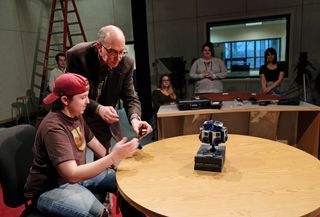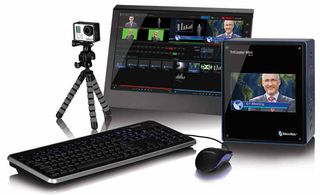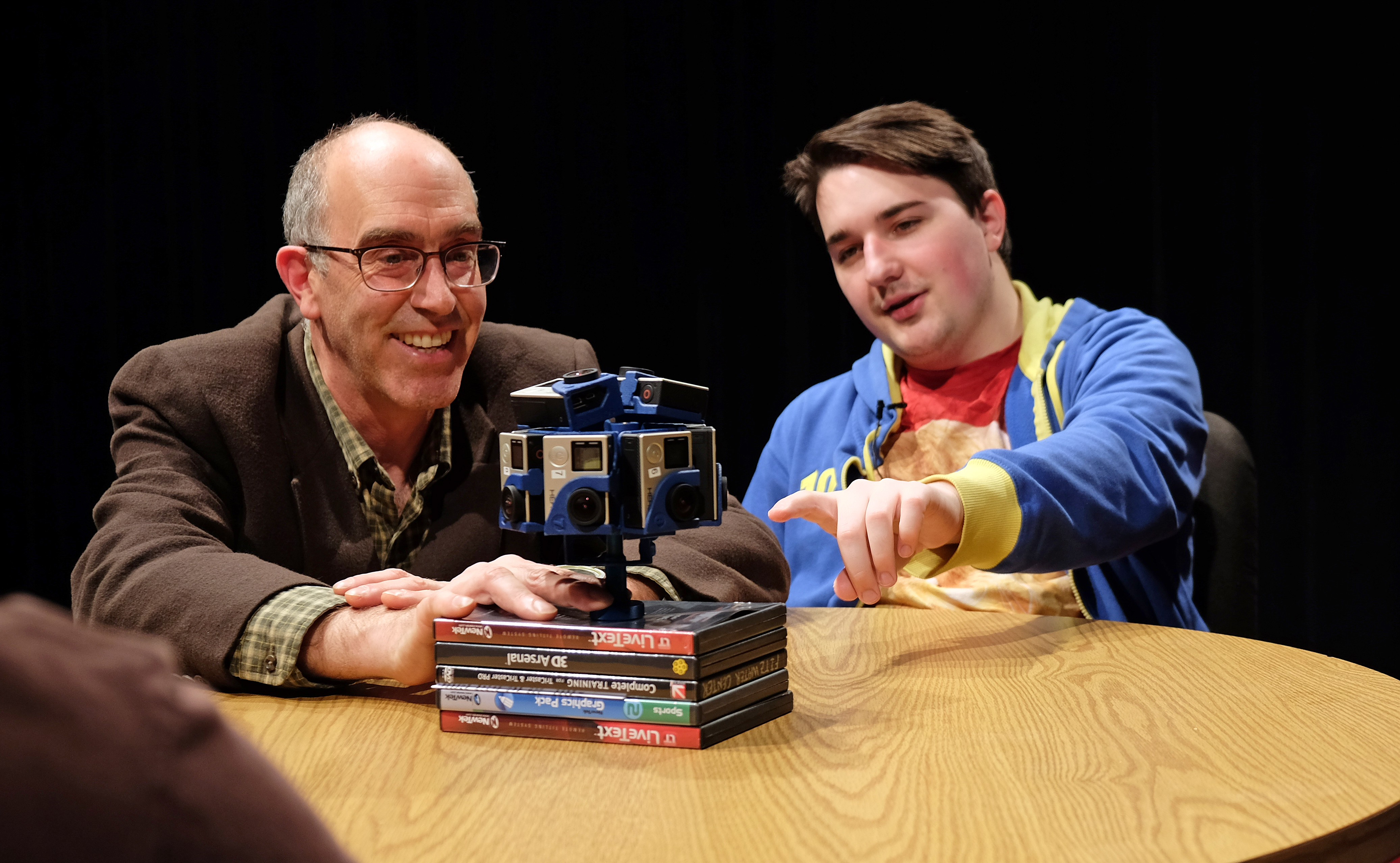For Richard F. Morse, the process is as interesting—and valuable—as the final product. Currently serving as the media technical specialist at Franklin Pierce University in Rindge, NH, Morse is encouraging students to collaborate and push the boundaries of creativity. New technologies are proving to be useful tools for educational inquiry.
INTERDISCIPLINARY ENGAGEMENT
Morse knows firsthand the value of interdisciplinary approaches in university classrooms: he holds a BA in literary studies from Middlebury College in Vermont and an MFA in film and media arts from Temple University in Philadelphia. In his post at Franklin Pierce University, he is enhancing pedagogy with audiovisual equipment and cutting-edge technologies. As new media tools like AR, VR, and 360 rigs hit the market, Morse sees exciting new opportunities for next-level storytelling.

As many higher education stakeholders know, every new semester ushers in different technological requirements, from projector adapters to BYOD support, to software updates. That often translates into needs assessments and refining departmental missions. A new endeavor in 2017 for The Depot—the division that provides the university with professional-grade audio and video field equipment, including six non-linear editing suites with Adobe Creative Suite software—meant splitting from the information technology’s media services function. Last year, The Depot moved into the Marlin Fitzwater Center for Communication (known as “the Fitz” and “Fitzwater”), a high-tech hub that houses innovative departments, vibrant academic degree programs like the communications department, social media and emergent technologies (SMET), and extracurricular programming. “The Marlin Fitzwater Center for Communication is all about the student experience,” said Dr. Kristen Nevious, director of The Marlin Fitzwater Center for Communication.
SOCIAL MEDIA AND EMERGENT TECHNOLOGIES
An interdisciplinary team of faculty passionate about technology—professors Paul Bush, Heather Tullio, Gary Heald, Dr. Raysa Erramilli, and Dr. Kristen Nevious—worked under dean Kerry McKeever’s guidance for several years to develop and create the social media and emergent technologies major, which was among the first of its ilk in the country. While the program was going through the curriculum committee, the university supported the GoPro technology at a time when it was cutting edge.
“There were few training courses to attend,” Nevious said. “We all—students and faculty alike—learned through immersive learning experiences. Our student media have been out in the field using the technology since the summer of 2016, covering the two national political conventions and exploring its storytelling capacity on campus.”
Professor Heather Tullio has used those experiences to develop the 360 Storytelling course, and this past semester was the first in which students were eligible to enroll. “At the same time, I worked with the student media to explore augmented reality applications in the newsroom, and I developed the course, which will be offered for the first time in the fall,” Dr. Nevious said. “We look forward to graduating our first SMET students in 2020, and we have no doubt they will be leaders in the field.”
Also new to SMET is professor Christopher Previte, who is the first full-time member of the program, and he is already contributing his expertise. He and Tullio are both leaders in the campus digital literacy movement.
NEW CHALLENGES, NEW LEARNING EXPERIENCES
With the transition from IT to Fitzwater came Richard Morse. His responsibilities now include teaching new media courses, managing studio operations, and supporting student and media productions.
Morse’s first months working in Fitzwater were busy with the transition from IT and related tasks such as streamlining audiovisual equipment inventory management. On any given day, you can find him teaching in one of the studios or classrooms, or supporting student editing or the recording of podcasts in the acoustically treated Internet Radio Studio. He also leads webcasts using the NewTek TriCaster and manages campus productions for live events. One such production included an ambitious six-camera shoot of the Presidential Installation, all with a student crew.
The cutting-edge technologies that Morse uses in the field are woven into his course syllabi, including his popular new class, 360-Degree Storytelling.
“We’re using our GoPro 10-camera array and VideoStitch, the stitching software,” Morse said. “We’re editing in Adobe Premiere, in the new 360 VR interface. The students are learning how to use 360-degree film technologies, and we’re exploring techniques to tell different kinds of stories.”
One example of innovative storytelling is a music video that the students are directing, filming, and editing. The project tells a story through dance and movement, calling upon the diverse interests of the Franklin Pierce students. From student choreographers and dancers to videographers, editors, and lighting experts, this music video is a case study in collaboration.
THE (VERY) BIG PICTURE
Other fascinating projects in which audiovisual technologies play a pivotal role are a new 360 video of the student-run volunteer fire department and a video of a gallery exhibit. “We’re using 360 in three different locations for the gallery video,” Morse said. “The professor, who is the artist, is recording a voiceover in studio B, and we’ll use some of his voiceover. We’ll be talking about his art, methods, inspiration, and all the other elements of his process.”
Morse explained how the students plan to cut the audio track and create a cohesive narrative using visuals from 360 to support it. “So if [the artist] is talking about what’s on the other side of the room, you can use the 360 technology to spin around and look at the painting that he’s talking about.”
ACADEMIC AND SYSTEMATIC
While the 360 rig was on campus before Morse arrived, he is a key part of the initiative to bring 360 video into the academic arena by teaching the inaugural course in 360 Storytelling. He is also slated to teach an augmented reality course next semester. A recent grant received by the school will help to upgrade the campus TV studio as well as its augmented reality and virtual reality tools. Oculus Rift virtual reality systems are one of the technologies that the Fitzwater Center received, as well as new 360-degree cameras that will allow students to shoot in and create stereoscopic content. “That is something that I’ve been a part of, as far as bringing to the school more ways to use our virtual reality in an academic context,” Morse said. The next logical step is how to use content and techniques honed in the academic setting for “telling stories in the real world.”
There is another valuable lesson to having emerging technology on campus: training students to be respectful of the equipment. “We know that we are on the forefront and technology is not easily replaced. It is expensive, and we want to get the most out of it before we move on to the next.”
ENHANCING CREATIVITY AND CAREER READINESS
While interfaces and operating systems change, the one constant is that there will be a new platform or new tool faster than you can say “hashtag.” Morse observes that his students are mostly comfortable with AV technology usage, even the latest iterations.

“They take to new technology really well,” Morse said, and shared that one of the attributes he appreciates about Franklin Pierce students is their “can-do attitude” and intrepidity in pursing goals. “In a way, they are fearless,” he said. “I tell them that they can make mistakes, so they’re willing to work, try new things, and experiment with the technology. And I think that they’re naturally inclined to some of the VR work because a lot of the students are gamers. They have headsets at home.”
Morse believes that the deployment of 360, VR, and AR technologies is happening across higher education, though some institutions are making it more systematic.
“The demand is increasing,” he said. Though many schools are just getting starting with teaching VR and augmented reality, “there is a desire to consume this kind of immediate content.” He recently attended the Intercollegiate Broadcasting Conference in New York where he met other media technical specialists and teachers. “We were exchanging ideas and sharing course materials.”
Morse’s advice for technologists and professors who want to make forays into emerging technologies, or pivot from traditional broadcasting into AR, VR, and 360, is to attend conferences with specific AR and VR tracks. He also encourages media technicians and AV departments to help faculty explore the possibilities. “I will be conducting faculty development to show someone in the science field how they could use an Oculus Rift. If they’re teaching anatomy, they could use some of the scientific programming that’s out there already and use that to enhance and augment their classroom experience. It can support the ways they teach and help reinforce core concepts.”
Ultimately, Morse believes what we now consider “new technologies” will become integral parts of our daily life. People are already interacting in their homes with smart speakers—voice commands are bridging the algorithmic and augmented reality worlds, he said. The fact that Franklin Pierce is at the nexus of emerging technology is significant.
“It’s unique at our school, being a campus of 1,200 people, that we are able to implement these technologies and have students on some of the latest equipment, so when they graduate and move into the workforce they can say, ‘Oh, I’ve used this. I know how to stitch. I was on the first version of it and I’ve watched it mature.’ I think that’s impressive that we’re able to give students these kinds of opportunities.”
Margot Douaihy is the editor-at-large of AV Technology.
Welcome to The Fitz
The Marlin Fitzwater Center for Communication—affectionately known as “The Fitz”—at Franklin Pierce University is dedicated to educating leaders of conscience in public communication. In addition to housing the University’s Department of Communication, the Fitz is the home for the University’s nationally recognized polling operation and the Pierce Media Group, which consists of the student-run newspaper, TV studio, Internet Radio Studio, and Raven Sports Broadcasting Network. http://www.franklinpierce.edu
Snapshot of Tech in The Fitz
- * Adobe Creative Cloud
- * Backbone Internet Radio Production Suite
- * Canon DSLR Cameras
- * GoPro Cameras and 360 Rig
- * Insta360 Pro Cameras
- * Marantz Recorders for Location Sound Recording
- * NewTek Tricaster and Tricaster Mini
- * Oculus Rift
- * Shure, Sennheiser, and Sony Professional Microphones
- * Microsoft HoloLens
- * Television Studio – FPTV
Go Figure
As reported in NewBay’s Installation, figures from analyst IDC forecast that global revenues for the AR/VR market will increase 100 percent or more over each of the next four years, with spending on AR/VR products and services expected to soar from $11.4 billion in 2017 to nearly $215 billion 2021. Take a VR Tour of Franklin Pierce University campus: https://www.youvisit.com/fpuravens/101873














